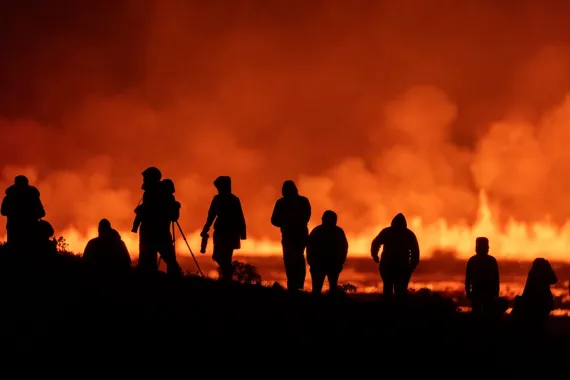MAUMERE, Indonesia — Indonesia’s National Disaster Management Agency announced on Monday that a series of volcanic eruptions on the remote island of Flores has resulted in at least 10 fatalities.
The eruption at Mount Lewotobi Laki Laki, which began around midnight, released thick, brown ash rising up to 2,000 meters (6,500 feet) into the atmosphere, with hot ash impacting several villages and destroying homes, including a convent for Catholic nuns, according to Firman Yosef, an official at the monitoring post for Mount Lewotobi Laki Laki.
He reported that volcanic material was ejected up to 6 kilometers (3.7 miles) from the crater, covering nearby villages and towns with significant amounts of debris and prompting residents to evacuate.
Abdul Muhari, spokesperson for the National Disaster Management Agency, stated that rescuers are still searching for additional bodies under the rubble of collapsed homes. All identified victims, including a child, were discovered within a 4-kilometer (2.4 miles) radius of the crater.
He stated that the eruption has impacted at least 10,000 individuals across six villages in Wulanggitang District and four villages in Ile Bura District. Many have sought refuge with relatives, while the local government is preparing schools to serve as temporary shelters.
The country's volcano monitoring agency raised the alert status of the volcano to its highest level and more than doubled the exclusion zone to a 7-kilometer (4.3-mile) radius after midnight on Monday due to an increase in eruption frequency.
Agusta Palma, head of the Saint Gabriel Foundation, which oversees convents on the predominantly Catholic island, reported that one nun in Hokeng village has died and another is missing.
“Our nuns fled in panic beneath a shower of volcanic ash in the darkness,” Palma stated.
Photos and videos shared on social media depicted houses in villages like Hokeng buried under tons of volcanic debris, with hot volcanic materials igniting structures.
Lewotobi Laki-laki is one of a pair of stratovolcanoes located in the East Flores district of East Nusa Tenggara province, locally referred to as the husband and wife mountains—“Laki-laki” means man, while its counterpart is Lewotobi Perempuan, or woman.
In January, approximately 6,500 people were evacuated after Mount Lewotobi Laki Laki began erupting, releasing thick clouds and prompting the government to close Frans Seda Airport on the island. Fortunately, there were no reported casualties or significant damage, but the airport has remained closed since then due to ongoing seismic activity.
During a video conference on Monday, Muhammad Wafid, head of the Geology Agency at the Energy and Mineral Resources Ministry, explained that the character of the eruption on Monday differed from that in January due to a blockage of magma in the crater, which reduced detectable seismic activity while increasing pressure.
“The eruptions that began on Friday were caused by the buildup of hidden energy,” Wafid stated.
This marks Indonesia's second volcanic eruption in as many weeks. On October 27, Mount Marapi in West Sumatra, one of the country’s most active volcanoes, erupted, emitting thick columns of ash multiple times and covering nearby villages with debris, although no casualties were reported.
Lewotobi Laki-laki is one of the 120 active volcanoes in Indonesia, an archipelago with a population of 280 million. The country is highly susceptible to earthquakes, landslides, and volcanic activity due to its location along the "Ring of Fire," a horseshoe-shaped network of seismic fault lines surrounding the Pacific Ocean.





No comments:
Post a Comment